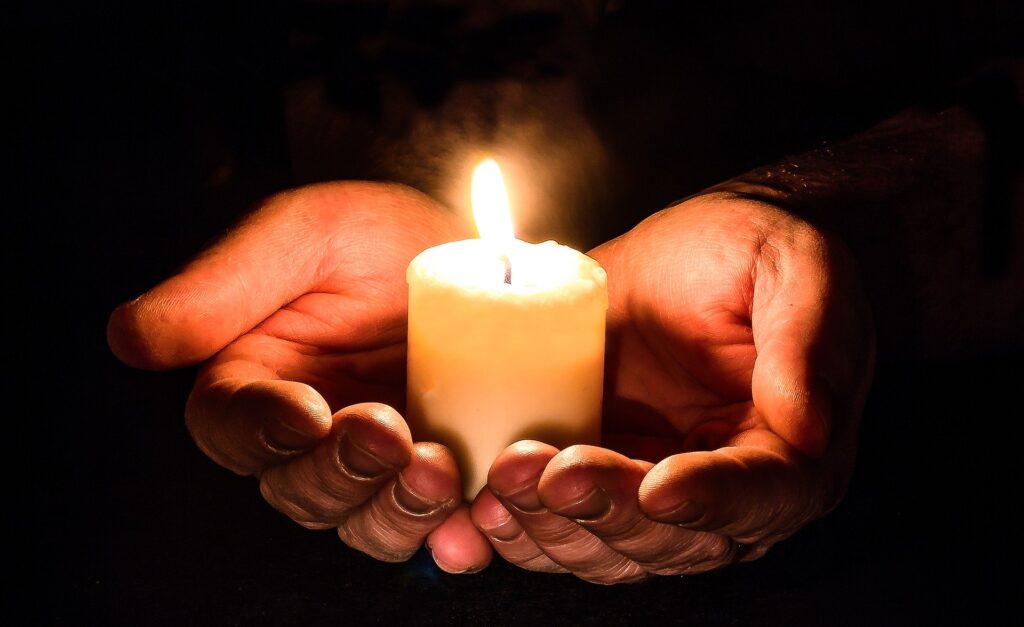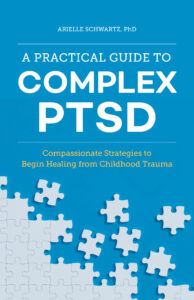
This book, A Practical Guide to Complex PTSD, is meant to provide compassionate support for the process of healing from childhood trauma. You can think of it as a lantern that will illuminate the dark spaces and provide a sense of hope in moments of despair.
The practical strategies you will learn in this book are taken from the most effective therapeutic interventions for trauma recovery. You will learn the skills to improve your physical and mental health by attending to the painful wounds from your past without feeling flooded with overwhelming emotion. My wish is to help you discover a new sense of freedom. The traumatic events of your past no longer need to interfere with your ability to live a meaningful and satisfying life.
“I have dedicated this book to those of you who have suffered from abuse or neglect as children and to the caring individuals who walk with you on your healing path. May the words and practices offered in this book provide guidance and inspire you with hope.” ~Dr. Arielle Schwartz

When we imagine the birth of a child, any child, we see a world that is safe. We envision a home filled with kindness and nurturance. While this home may not be perfect, it is a place where a child is able to learn and grow with curiosity and joy. Childhood trauma is a betrayal of this unspoken promise.
Complex post-traumatic stress disorder (C-PTSD) is a response to traumatic events that were ongoing or repeated. With childhood trauma, these events occurred in your early years and were likely to be unpredictable, chaotic, or terrifying. You may have had parents or caregivers who abused, neglected, or abandoned you repeatedly, or you may have seen repeated traumatic events. The “complex” aspect of C-PTSD means that the trauma was at an early enough age or was repeated often enough that it affected your emotional development.

“My wife gets frustrated with me because I don’t talk to her about my feelings. My problem is that most of the time, I don’t know what I am feeling or what I want. When I was growing up, I wasn’t able to talk to anyone and I certainly couldn’t ask for anything. Either they ignored me or I was sent to my room. I guess I stopped having needs. She asked me to go to therapy because she feels I’m too distant; she thinks I’m depressed. I think that this is just who I am.”
Ideally, caring parents help their children know that it is okay to have feelings by lovingly supporting them during moments of sadness, hurt, or anger. These types of interactions communicate to a child that it is okay to be vulnerable and that it is normal to have needs. In contrast, Leo’s story is a powerful reminder of the painful consequences of childhood emotional neglect. His lack of parental support resulted in avoid of inner awareness, an inability to recognize or articulate his feelings or needs.
In therapy, Leo spoke in a matter-of-fact tone, without any emotional expression on his face. Slowly, we began to turn toward the grief and loss of the young boy who had given up hope that anyone would ever really understand him or meet his needs for connection. Initially, this involved helping Leo identify when he was having feelings. We made space for the painful emotions of anger and sadness he felt toward his parents. He had spent many years in denial of his needs; however, we discovered that beneath his self-reliant disguise, Leo still had genuine needs for connection and love. He discovered that it was not too late; he could learn to feel his emotions.

There are many resources offered throughout in the form of healing strategies that you can practice to build your capacity to reclaim a sense of safety. For example, you will be guided to recognize dissociative symptoms when they arise and, if you choose, to slowly, mindfully return to sensing and feeling your body and emotions.
Somatic psychology teaches that you can learn to recognize emotions by focusing on body sensations. For example, you might notice that you feel tightness in your chest when angry, a lump in your throat when sad, or a feeling of contracting inward during times of shame. It may require a regular practice of checking in with your body before you start to make connections between your sensations and your emotions. In addition to building your own somatic awareness, it is valuable to have another person, such as a trained therapist, participate in this step. That other person can help you recognize the subtle shifts in your facial expressions or body language that can help you tune into your feelings.
You can explore your emotional self-awareness by bringing to mind a memory of a difficult event. Notice any changes in your body sensations. What do you imagine you were feeling during that difficult event? See if you can draw a connection between areas of tension in your body regarding an event and your emotions about that event. The next step involves giving space to listen to, honor, and express your feelings.
For example, the benefit of recognizing and expressing anger is that this emotion can give you the energy you need to free yourself from depressive symptoms. When sensing anger, you might notice a feeling of tightness in your chest and arms or a surge of energy in your belly or legs. Embracing anger in a healthy way might look like giving voice to the previously unexpressed feelings of betrayal, hurt, or rage that you have never expressed to an abuser. This can help you to find the energy to start exercising, which further boosts your mood. Or, you can direct your anger into the completion of a project, which in turn increases your self-esteem. Anger is also an emotion that redirects your energy toward self-protection, which can help you define your boundaries or communicate your needs assertively.

You cannot rush the healing process. It takes approximately 20 years for the human brain to fully form and many years of careful guidance to help a child develop the social and emotional intelligence to navigate the complexities of adulthood. Our earliest years should prepare us for the inevitable challenges of life, such as working through conflicts with loved ones or coping with loss. However, when you have grown up with childhood trauma, you have to fill in the gaps left behind by neglect or abuse, and this takes time. I encourage you to recognize that reclaiming your life from childhood trauma requires a long-term commitment to yourself and to the healing process. Your symptoms are the result of traumatic injuries that occurred over an extended period. It is important to be realistic about the time line for healing.
In time, it is possible to reclaim a secure sense of self. Each tender moment of growth stretches your body, mind, and soul. Initially, you might feel shaky and unsure. Like a child just learning to walk, you explore new territory and you may falter. But with encouragement, you get up again and again. With practice, you develop greater faith in your capacity to sustain a positive mindset and a hopeful outlook toward your future. Remember, these hard-earned insights and experiences of empowerment cannot be taken from you. Eventually, you will reach a tipping point of growth at which you no longer identify with the shame and burdens of your childhood wounds. You can let go of the pain; you can learn to stand with unshakable confidence in the basic goodness of who you are with the knowledge that you not only deserved it but also that it is the inexorable birthright of all human beings.

Healing from trauma doesn’t mean that you will no longer experience times of emotional distress. In fact, you may need to accept that, no matter how hard you try, some of your symptoms will persist. This is not a sign of failure on your part; it is a reminder that the effects of complex trauma are often profoundly layered and held deeply within the mind and body. Remember that reclaiming your life from childhood trauma requires a long-term commitment to yourself and to the healing process. My hope is that this awareness can help you reconnect to self-compassion, rather than leave you feeling discouraged or hopeless.
Think of this book as a resource during times when you are experiencing distress.

As a compliment to the Complex PTSD Workbook, A Practical Guide to Complex PTSD: Compassionate Strategies for Childhood Trauma, is meant to provide compassionate support for the process of healing from childhood trauma. You can think of it as a lantern that will illuminate the dark spaces and provide a sense of hope in moments of despair. The practical strategies you will learn in this book are taken from the most effective therapeutic interventions for trauma recovery. You will learn the skills to improve your physical and mental health by attending to the painful wounds from your past without feeling flooded with overwhelming emotion. My wish is to help you discover a new sense of freedom. The traumatic events of your past no longer need to interfere with your ability to live a meaningful and satisfying life. Click here to Order on Amazon.

Dr. Arielle Schwartz is a licensed clinical psychologist, wife, and mother in Boulder, CO. She offers trainings for therapists, maintains a private practice, and has passions for the outdoors, yoga, and writing. She is the developer of Resilience-Informed Therapy which applies research on trauma recovery to form a strength-based, trauma treatment model that includes Eye Movement Desensitization and Reprocessing (EMDR), somatic (body-centered) psychology and time-tested relational psychotherapy. Like Dr. Arielle Schwartz on Facebook,follow her on Linkedin and sign up for email updates to stay up to date with all her posts.

Arielle Schwartz, PhD, is a psychologist, internationally sought-out teacher, yoga instructor, and leading voice in the healing of PTSD and complex trauma. She is the author of five books, including The Complex PTSD Workbook, EMDR Therapy and Somatic Psychology, and The Post Traumatic Growth Guidebook.
Dr. Schwartz is an accomplished teacher who guides therapists in the application of EMDR, somatic psychology, parts work therapy, and mindfulness-based interventions for the treatment of trauma and complex PTSD. She guides you through a personal journey of healing in her Sounds True audio program, Trauma Recovery.
She has a depth of understanding, passion, kindness, compassion, joy, and a succinct way of speaking about very complex topics. She is the founder of the Center for Resilience Informed Therapy in Boulder, Colorado where she maintains a private practice providing psychotherapy, supervision, and consultation. Dr. Schwartz believes that that the journey of trauma recovery is an awakening of the spiritual heart.